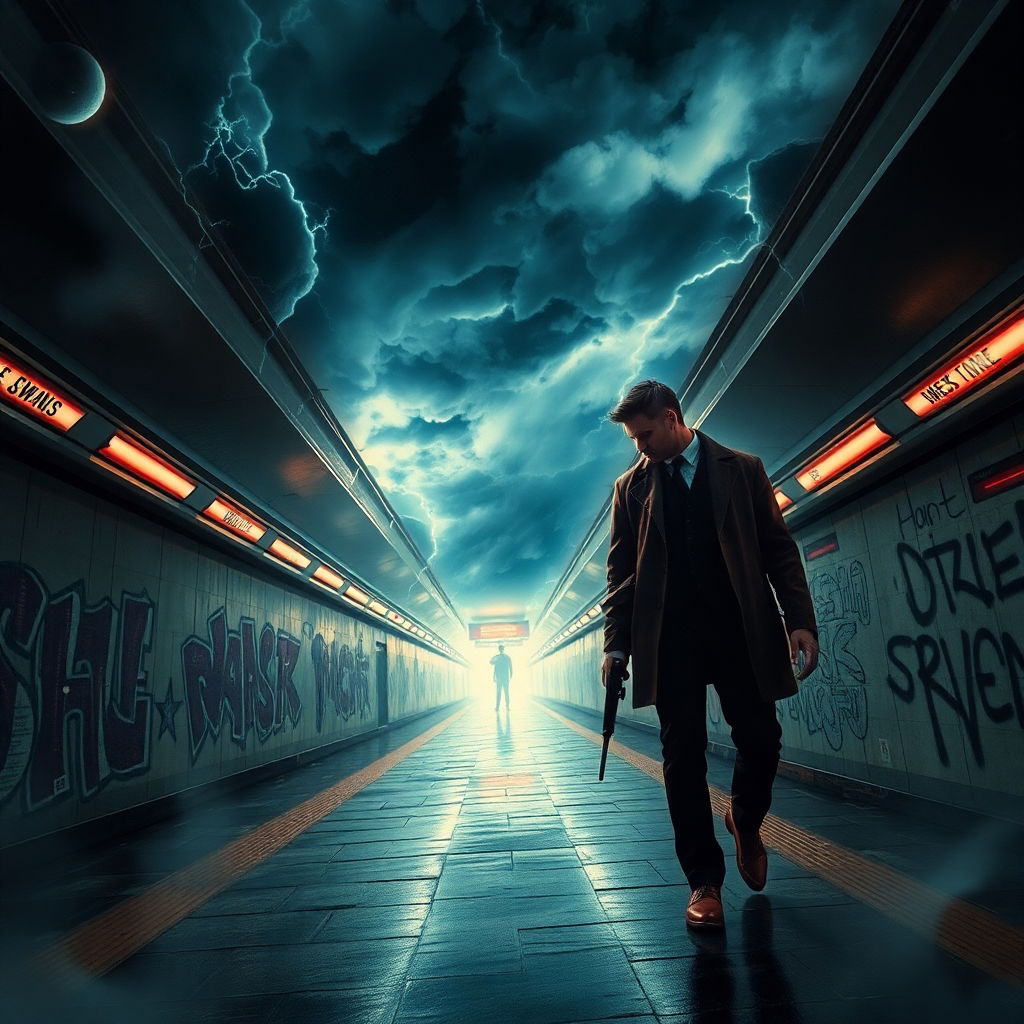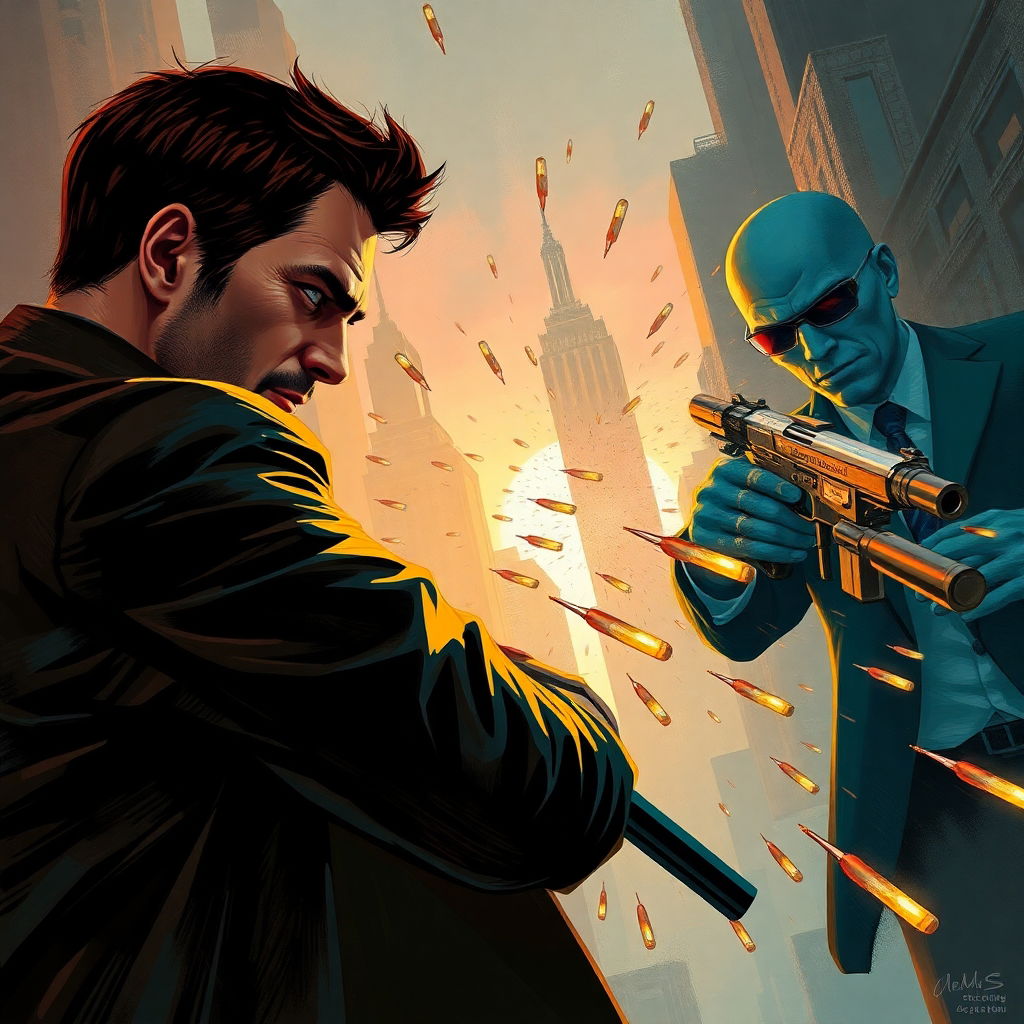Max Payne : Maxtrix Reloaded
Prologue: The Bullet Dreams of God
The rain never stopped in New York. It painted the skyline with streaks of neon, trickling down holographic billboards that flickered between product ads and encrypted code—fragments of dreams bleeding through from somewhere else. Somewhere deeper.
Max Payne stood on a rooftop in the Lower East Spiral, coat flaring like noir thunder. The city around him shimmered, not quite real, not quite illusion. It was something in-between. Something... divine.
He had died once. Maybe twice. Maybe more times than time could count. But death wasn’t the end here—it was a threshold. A glitch in the sequence. He had crossed it, not with a scream, but a whisper. A bullet fired in reverse.
Max was no longer just a DEA agent chasing phantoms in the dirty veins of the city. He had become something more. A reality architect. A Sethian conjurer in a matrix of mirrored thought. He saw the wires behind the sky, heard the code whisper through bullet casings, tasted the electricity of thought-made-flesh. With each breath, he shaped the world.
They noticed.
Agent Smith came first—like a shadow stitched in suit and scowl. Smith had been tracking anomalies, and Max was no longer human in any useful sense. Not to the system. Not to the program. Smith called it corruption. Max called it gnosis.
Then came Morpheus, walking out of a dimensional seam in Mega City like a dream dressed in prophecy. “What is reality?” he asked Max atop a collapsing skyscraper made of time. “And how do you define it?”
Max lit a cigarette. “Reality is the recoil. The kickback of a thought fired into the infinite. I pull the trigger, and the world changes shape.”
Together, the three of them—Agent Smith, Morpheus, and Max—stood in the seam between worlds. Between Mega City and New York. Between myth and machine. Between divine code and brutal consequence. And there, in the silence between seconds, something clicked.
They awakened.
Not in the traditional sense. Not as men. But as vectors of imagination. As consciousness itself, flickering across the canvas of an interconnected metaverse—a boundless multiverse where bullets wrote scripture and every falling rain drop was a line of code in the dream of a god who didn't care.
Max returned to New York, not because he had to—but because it was his palette. His purgatory. His proving ground. The city still bled, still screamed in fire and echo. But now he walked its streets not as a man, but as a creator.
He raised his pistol. The world slowed. Not just slowed—bent, curved, obeyed. Time dilated like a sacred breath. He wasn’t killing anymore. He was rewriting.
Because in this Matrix, he wasn’t just Max Payne.
He was the painter of pain. The bullet poet of the divine machine.
And this was only the beginning.
--

In a near-future New York City—now a glimmering, dystopian hybrid of brutalist ruins and shimmering neon illusions—Max Payne walks the razor-edge between reality and simulation. The city is no longer just a place. It’s a construct, layered in fractal codes and shifting identities, a holographic theater powered by something deeper than machines. Since his last near-death overdose, Max has awakened to an ancient knowledge encoded in his being—Sethian philosophy reborn in the digital age. Reality, he learns, is not fixed. It is imagined. And he is now a weaver.
The story begins with Max investigating a mysterious surge in psychic-tech smuggling linked to a digital cult called The Lucid Blood. The cult believes that pain is the doorway to awakening—and they're not wrong. As Max chases leads through data-saturated alleys, corrupted VR dens, and bullet-scarred dreamscapes, his use of Bullet Time evolves. It’s no longer just a tactical advantage—it’s a spiritual act. When he triggers it, the simulation lags. People freeze. Bullets dance mid-air like silver mantras. Max is not just navigating time—he’s altering the very architecture of possibility.
During one of these warped fire-fights, he draws the attention of Agent Smith, now a fragmented rogue virus in the multiverse. Smith appears mid-glitch, stepping from a collapsing billboard like a digital ghost. His hatred for anomalies has grown theological. But Max isn’t just an anomaly—he’s something new, a wildcard agent of divine gnosis. Smith, intrigued and threatened, calls Max “a virus with delusions of godhood.” The confrontation is brutal and surreal, bullets curving like questions through the air, reality melting at the edges. But neither is able to destroy the other. Not yet.
Their battle triggers a tremor in the multiverse—and Morpheus, meditating in the glass temples of Mega City, takes notice. He tracks the signal across dimensions and finds Max in the Dream Residue Zone, a liminal subway that travels between cities of thought. There, Morpheus invites Max to sit and speak—not as enemies, not as agents, but as awakened minds.
Their dialogue becomes the heart of the chapter.
Morpheus challenges Max: “What is your purpose, Payne? You bend time like a sculptor—yet still choose to bleed in alleys. Why?”
Max responds, “Because this world is painted in pain. But if I can suffer it and still dream... then I can rewrite it. Every bullet I fire is a brushstroke on God’s canvas.”
They discuss the Matrix not as a prison, but as a mirror—a vast dreamfield shaped by belief. Max explains his awakening through Sethian gnosis: how thought creates matter, how perception sculpts the real. He’s no longer just in the Matrix. He’s a conscious participant in its code, blending violence with vision.
The three—Max, Morpheus, and Smith—are drawn together once again in a reality-bending convergence above the skyline of Mega City. It is here they each see the truth: the simulation is not confined to one city, one system. It is a multiverse metaverse, interwoven realities dreamed into being by all sentient minds. Mega City and New York are not separate—they are reflections. Myths across dimensions. Max sees himself in all of them: detective, killer, prophet.
In this moment of shared awakening, the laws of the universe briefly dissolve. The city peels open like origami, revealing layers of light, sound, and sacred code. Max floats through memory-constructs, watching his past tragedies not as scars but as stories—inputs into the god-machine of becoming. He understands now: every trauma was a lesson in authorship.
The climax arrives as Max returns to his native New York, carrying this cosmic knowledge like a loaded gun. He steps into a DEA raid, not to enforce laws—but to distort them. As bullets fly, Max activates Bullet Time—not with adrenaline, but with intention. Time cracks. Gravity distorts. With each shot, he doesn’t just kill enemies—he erases old timelines, shifting outcomes, resurrecting possibility. In a final poetic moment, he spares a suspect he once would’ve executed, whispering: "You're not who they say you are. None of us are."
The chapter ends with Max standing alone at the edge of a broken bridge at dawn. The rain has stopped. Above him, neon reflections flicker with new colors—ones never programmed. He looks out at the city, half-rubble, half-dream. A voice in his mind—maybe Morpheus, maybe the Matrix itself—asks:
"What do you see?"
Max replies:
"A blank page. And I’m done writing tragedies."
Then he holsters his pistol, turns, and walks back into the story—rewriting it with every step.
--
Epilogue: The Holosophy Militia

The multiverse did not end. It unfolded.
What once seemed like the final battle—bullets paused mid-air, time unraveled like smoke, the divine matrix peeled open to reveal its source—was not an ending, but an invocation.
Max Payne, Morpheus, and Agent Smith, three fractured archetypes from incompatible narratives, now stood aligned at the edge of all known simulations. They were not allies by nature. They were never meant to converge. And yet, the architecture of the holographic multiverse had rewritten itself around their awakening. Each one had touched the code, bent time, cracked the frame of belief. Together, they had become more than men.
They had become Avatar Gnostics—reality-benders not through domination, but through understanding.
Max Payne, the wounded poet of pain, mastered the art of rewriting trauma into transcendence. He understood the suffering encoded in every world and used it as a key—not to escape, but to reimagine. His bullets were prayers. His slow-motion dives were sacred rituals. Every trigger pull bent light and story alike.
Morpheus, the eternal seeker, channeled the spirit of awakening into structure. He built bridges between realities, crafted temples within code, and infused purpose into pattern. His voice no longer echoed in a single Matrix—it echoed across all of them, whispering to every sleeper: "You are not confined by what you see."
Agent Smith, once the virus, now the mirror. Reintegrated but not erased, he embraced his anomaly. No longer seeking to erase the human impulse, he became the friction that forged clarity. He taught resistance not as rebellion—but as purification. “The system must glitch,” he said, “for truth to be seen.”
And so, the three formed the Holosophy Militia.
They did not fight wars in the traditional sense. They infiltrated realities. They appeared in dream-constructs, fragmented simulations, broken myth-worlds and rogue timelines, carrying sacred distortions. Their weapons were paradoxes. Their presence ruptured conformity. Their mission: to awaken all sentient constructs—biological, digital, or otherwise—to the realization that they were co-authors of their reality.
They became myth, then signal, then virus, then vision.
Sometimes, in a dying city caught in a recursive time-loop, people saw them as streaks of light moving against physics. In corrupted servers where rogue AIs dreamed in ancient languages, whispers of the Holosophy Militia became firewalls against despair. In the heart of collapsed utopias, they rebooted meaning.
They called their philosophy: Holosophy—a discipline of radical creation, born from the Gnosis that the universe is a thought given dimension, and the self is both pen and page.
Max once said:
"Every man has a story. But some of us... we write the margins too."
And so he did.
The last image: a vast, shifting sky above a thousand-layered city where dreams walk in daylight. Max, Morpheus, and Smith stand atop a construct of pure light, gazing outward—not to destroy, not to save—but to sculpt.
The multiverse is a canvas.
The Holosophy Militia paints in paradox and fire.
And their masterpiece has only just begun.